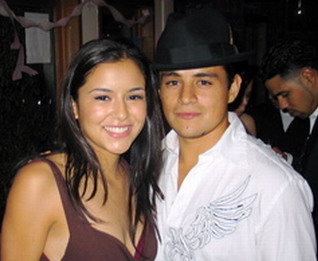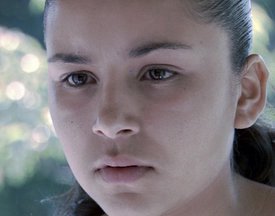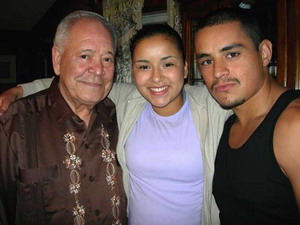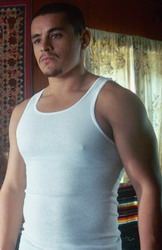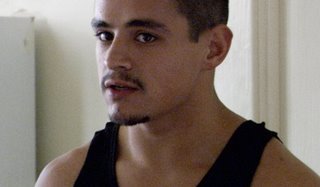
Quinceañera gracefully maneuvers a dance between tradition and innovation, cognizant that without such a dalliance, neither can exist. Traditions are furthered through innovation just as innovation requires tradition as its source. Capturing the heart of this dance, codirectors and real-life partners Richard Glatzer and Wash Westmoreland won Audience Favorite and the Grand Jury Prize for Drama at this year's Sundance Film Festival. They enthusiastically sat down with me in the Mark Hopkins Ambassador room to talk about their successful indie film.
Michael Guillén: You guys, you've made a lovely film, so much heart in this film. Let's talk about the heart of it and how it got started: I understand you had a neighbor who wanted you to photograph her quinceañera? I wanted to know what it was that you saw in that celebration that pulled you in to subsequently shoot a feature?
Richard Glatzer: Yeah, we did photograph our next-door neighbor's quinceañera and we were amazed by the ceremony, by the months of preparation, by the fact that all these teenage kids with teenage hormones and teenage energy were taking it so seriously; were learning these formal waltzes and so on. We were amazed once we saw the day how it was a kind of contrast of very old traditions with contemporary Los Angeles. That was interesting. I think we were also amazed by what a communal kind of thing it is because people padrino and madrino [i.e., godparent] different aspects of the quinceañera so that a very poor family can have an elaborate day….
Wash Westmoreland: Lots of donations through the padrino/madrino….
Richard: Yeah, someone will say I'll take care of the details, I'll take care of the dress, I'll take care of the food, or whatever. The community comes together to make it this magical day for the girl turning 15. At that point we didn't really think about making our own film about it. It did seem very cinematic to us. I remember saying to Wash, "This should be a movie" but didn't really think we were going to be the ones to do it. But a few months later we were sitting around, it was New Years Day 2005, and we were talking about our block and our neighborhood and how fascinating it is that there were such different cultures door to door, one right next to the other, and that it would be a really fertile ground for a film. Within two hours we had our characters. We had the idea of two teenagers coming of age, Magdalena and her cousin Carlos. We just found ourselves really compelled by the idea of kids who were rejected by their immediate families and had to form a kind of outsider family with their great-uncle. Wash should talk about the great uncle.
Wash: The great-uncle to me is the heart of the movie.
MG: Yes, he is.
Wash: I think the way Chalo González played that character is just incredible. He's 81 years old and this is his first starring role. He brought this lifetime of experience into that part. From the writing point of view, the inspiration for the Tio Tomas character was actually my great-uncle who was a Yorkshireman who was a single, great-uncle. He was my grandmother's twin. He just had this great attitude. When I was around 11 years old, he came and actually moved in as a parent to cook and clean and look after us. He was a non-judgmental mentor. He didn't care—I was having problems coming out sexually and all that kind of adolescent stuff—and he just didn't care. He was very non-judgmental. He was just accepting. And so when we thought of these two kids being thrown out of their houses for sexual reasons, we thought the third piece of the puzzle is the Tio Tomas character and he'll be the glue that makes the new family stick together.
Richard: I got to know Wash's great-uncle and the film was dedicated to him.
MG: I loved the scene where his back is to the camera and he says to Carlos, "Are you seeing your special friend? I'm glad you have a special friend." That was such a throwaway epiphany! Beautiful. Absolutely beautifully staged and beautifully filmed, beautifully enacted, I was so impressed.
Wash: We tried to keep a lot of the very deep felt emotions in the movie, not to overplay them, not to spoon feed them to the audience, but just to allow the characters a dignity in how they express those emotions. I think what Tio Tomas is saying to Carlos is this unconditional love he's giving him, and he's just letting him know that he knows and it's fine. But he does it in the most offhand way and I think that's what gives it its emotional power.
MG: Well, all the quinceañeras are in town. There's an exhibit out at the deYoung, which I'm sorry you don't have time to see, it's Cheech Marin's Chicano art exhibit, the largest Chicano art collection in the United States. In that collection is Carmen Lomas Garza's painting Quinceañera. [I show it to them.]
Wash: How fantastic!
MG: Like your film, it's full of pink dresses. I wish you could make it out there to see it, but, I understand you're on your way to Denver this afternoon?
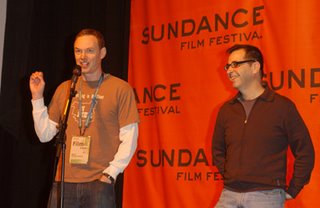
Wash: Yeah. I would love to see it. We obviously made our film called Quinceañera but now we're hearing the word a lot. There seems to be this kind of bubble right now. It seems to be like every time you open a newspaper there's an article about it or there's a new magazine that's just started called Miss Quince Años. Initially, when we thought of calling the film Quinceañera, we thought, "Well, Latino people know what this is but the majority of white Americans won't know what this is. So it's time to teach them. Let's put this word in the popular lexicon and let's give white girls quinceañera envy." It's really an amazing tradition and it's here in America.
MG: Which leads me to ask you about the reception for this film. Quinceañera is down the middle. People either really love this film or they just don't get it and think it's inapplicable. That's the critique that—as a Chicano—gets on my nerves when I read, "Who's going to care about these characters?" Who is going to care about these characters?
Richard: When you make a film, you make it because you're attached to the story and you want to tell your story. Of course, we're hoping by making this film to break down the barriers between cultures. That's the real motive behind it for us. I don't know what the reaction is going to be. We've had a great response so far from the Sundance Film Festival and from a lot of the critics.
MG: Yes, congratulations on that, by the way.
Richard: I do think when the film was up for distributors to buy it, that there was a certain amount of concern that the Latino public can't accept a film with a gay component in it. We thought that was a racist, stupid, antiquated approach. We don't know. I don't dare generalize about the Latino public because I'm not Latino. But I'm thinking things are changing. They have to be. Post-Brokeback Mountain, is this such a subversive thing to have in a film about a Latino community? I don't think so.

Wash: It's interesting as well, we moved into a Latino community as a white gay couple and we thought, "Oh, are people going to be keeping their distance?" No one was. We were accepted on our street, which was a very nice thing. No one made a big deal out of it. I feel the film addresses the issues in a way that's not in your face. A lot of people can go see the film and go along with the story. There's certainly a mirror in Carlos' storyline between the homophobia of his parents who reject him in the Latino community and the coded racism of the white gay couple. Through these storylines these issues have been brought out. We want to put those issues out there for people to talk about and discuss. And yet, if a piece of art works it's meant to create some friction and it's meant to have some detractors because that's what you're trying to do; you're trying to question people's attitudes and shake things up a bit.
Richard: If everybody were complacent with the film, you'd feel like, "Maybe we're not touching any material that has any charge to it."
Wash: We wanted to make a sugarcoated subversion.
MG: You needn't worry, there's a lot of charge to this movie and, you're right, it's not in your face; it's in the back of your mind. I walked away from this film irritated by some things. One of them was exactly what you were talking about, Wash, the "coded racism" of gay people. As a gay man myself, I've been at that dinner party one too many times. [Laughs.] The gentrification process, which is usually attached to gay men, this was a stickey wicket. I know some critics have moreorless insinuated that there is a reverse discrimination in cinematic representation going on in your film. This is as intriguing as it is troubling for me. I recently interviewed Larry Clark of Wassup Rockers where the same criticism has been levied. What is your response to that critique that you have caricatured white people and glorified Latinos?
Richard: The white gay couple in the film are not the most positive people on the planet….
MG: But they're real.
Richard: For us they're very real. If you listen to their dialogue, especially things that Carlos overhears the other side of their door, you understand the parameters of their relationship. There is an economic disparity between them. One is working and paying the bills, the other one only works intermittently. They've bought a house that they can't really afford. There's a lot of friction because of the economics of the situation. They also have certain parameters in their sex life where it's okay to have threeways, it's not okay to have separate affairs. Carlos falls into this spider's web of different conflicting emotions.
Wash: But we're not saying white people bad. We're saying these people are in a situation and they're economically blinkered and they're also emotionally blinkered as to what Carlos's needs are from that relationship. Also, Carlos's parents are equally blinkered because they're not giving him any outlet to express his sexuality. They've thrown him out of the house because they've found out through Google where he's been going on the Internet. There's no Latino good white people bad.
Richard: There's a whole range of characters in the Latino community in the film and there are people like Carlos's parents who are narrow-minded and also some of the girls in Magadena's group turn very nasty once they found out she's pregnant. We've been accused of turning all the Latino characters into saints but if you look at the film that's hardly the case. There's also some white characters—there's a woman who appears near the end of the film who is a white liberal trying to be much more open and understanding than the couple that Carlos gets involved with. So we don't feel it's a legitimate complaint about the film.
MG: I don't think it is either and I must commend you for tackling the two themes: the coded racism and the eroticized fetishism of young Latino males. My story is very similar to Carlos's. I left home at 15. I entered the arena of love hoping to get the support I had not received from my family and was consumed by a subculture that used me up and didn't really care about my particular needs. Carlos's realization when he overhears the couple and he realizes the guy doesn't love him was heartbreaking because he's been used.
Wash: Yeah, he's been used.
MG: …and I found that very touching.
Richard: Thank you.

Wash: Thank you very much. Yeah, in the film everyone's talking about the hot real estate market and we wanted to say, "Well, what's it like from the point of view of the renters?" Similarly, hot Latin guy, threeway, sexual excitement, what's it like from the point of view of the plaything who happens to have emotions and happens to need mentoring? Carlos is a new type in that he has gained all his information about sexuality through the Internet and online, which is how I think a lot of people do nowadays find out about their sexuality. Before he actually physically comes into contact with any gay people, he's developed very much a sense of himself just through this new technology. So when he goes into that white gay party for the first time, he's seeing this huge culture clash with different parts of who are the gay community. He doesn't identify with the mainstream gay style and he doesn't participate in any of these real estate conversations and he's very much outside the mainstream gay culture. Yet, he needs some kind of mentoring. He needs someone to reach out to him and show him that it's okay to be gay. In the end he finds out from his cousin who's pregnant and from his uncle. That's where he gets his acceptance from.
MG: Who came up with the peanut butter line?
Wash: [Laughs.] I think that was one of mine.
MG: That was very funny.
Wash: Emily said that line and afterwards I said, "Oh, we never really talked about this. Are you okay with saying it?'' And she goes, "Yeah, I'm fine. I don't really understand what it means." I was like, "Okay."
MG: This was another thing that was intriguing to me. When people think of Latinos, they mainly think of Roman Catholic; but, the statistics are that actually more Latinos are becoming evangelical because of its conservative allure. I thought you guys accomplished this Roman Catholic overlay on the evangelicism very well. Was that difficult?
Wash: The family that came from Mexico were Catholic and it was in L.A. that the storefront church became the main focus for the parents' generation. Tio Tomas's generation, the older people in the family, would still be more identified as Catholic. I think that's happened to a lot of Latino people coming to America. There's a growth in storefront evangelical churches in Los Angeles that have a visceral appeal to people and have taken people away from the Catholic Church to be evangelical. We wanted to show that change too as a result of different generations.
Richard: Also, the church that we shot our neighbor's quinceañera in is the church in the film and it's her family who runs that church, they are evangelicals, and we were very taken with that mural that opens the film and recreating what we saw. We decided to make that family evangelical and, as Wash said, then have Tio Tomas be in the Catholic faith.
Wash: Our production designers brought in lots of crosses and virgins and Guadelupes to hang up and they were like, "No, no, no, no!" We realized that was a misunderstanding. There is no direct iconism in evangelism. In this particular evangelical church, they have no iconism at all. Whereas, of course, Catholicism is completely steeped with iconism.

MG: It was an interesting tension. The scene where the father says there is no such thing as a pregnant virgin and Tio Tomas clutches his medallion of Guadelupe was especially poignant for me because—as an aficionado of Chicano iconographic studies—the Virgin of Guadelupe has been one of my main focuses. One thing I wanted to present to you and where, again, I must commend you is that—within my own studies—you have taken the legend of Guadelupe one step forward and given it a unique cinematic inflection it has not had until now. Most people don't understand that the Virgin of Guadelupe is based upon ancient Nahuatl goddesses—Tonantzin and back to Coatlicue. The floral pattern on her robe—the nagvioli—is an ancient Nahuatl symbol connecting her to Coatlicue, who was a pregnant virgin who gave birth to their solar deity Huitzilopochtli. When Coatlicue's family found out that she was pregnant, they were furious, just like Magdalena's family was furious. This is all in the mythology. This is ancient Nahuatl mythology.
Wash: Amazing!
MG: I was watching this movie thinking—not only did you deal with some sensitive issues about teenage pregnancy and a young Latino gay boy—but, you had this plot line that probably no one would have expected about a virgin pregnancy, which I was fascinated with, precisely because it links into this ancient tradition and a continuity of image. The fact that Guadelupe's wearing a sash means she's en cinta, she's pregnant. It isn't just that she's the Virgin Mary giving birth to Jesus, this is a Nahuatl overlay on Christian teachings.
Richard: The same way the quinceañera goes back to Aztec times.
MG: I was wondering if you were conscious of that? Sometimes I think the imagery is so strong that—even if you just use it—energies are invoked by reference and invited through the imagery, even if you don't know.
Richard: It was very important for us that Tio Tomas be Catholic to work that imagery in there. We couldn't get it in terms of Magdalena's house or church or that whole evangelical aspect of her life. So for us it was very important to have the Virgin of Guadelupe even though I can't claim to have this knowledge of Nahuatl history. We definitely wanted that image; it was very strong for us to have that there, to have Tio Tomas in a casual way be able to refer to it.
Wash: We thought there was a great comparison between Magdalena's situation, where she's been rejected from that family, and the situation of the Virgin of Guadelupe who's being worshipped by the family. We thought there was this amazing situation.
MG: That they weren't listening to their own teachings.
Wash: Yeah. Exactly.
MG: That was a powerful scene when the father reconciles with the daughter.
Richard: What we think is so interesting about that is that they both are persisting in their beliefs. They haven't come to an understanding.
Wash: They just decided they're going to reconcile but they don't have to see things the same way.
Richard: It's almost like she's the more mature one who allows him to have his belief.
MG: She is the more mature one. Emily's performance in this film is just this side of brilliant for being understated and so heartfelt. How did you find her?
Richard: She just came through the door and blew all those 19-year-old Beverly Hills girls out of the water. We were encouraged to cast somebody who was 18 years old so we'd have more time to work, not just six hours a day on the set, which is all you're allowed with a 15-year-old. Certain people—I won't say who they were—were taken by a slicker acting style and we saw Emily and we thought, no, that's the real thing and that's the kind of acting we like that's understated and very interior and very felt. We kept bringing her back because she was a 15-year-old girl who only had on her resume that she played Cleopatra in a school play and she had to carry the damn movie, so we wanted to know that—and we loved her superficial toughness, we loved the fact that she's from El Monte and has that East L.A. thing—but we wanted to know that emotionally she had that kind of depth that she would really have a relationship with her father, that she would really care about her father, that she would feel romantically about her boyfriend and so on. So we put her through her paces. We drove her a little bit crazy. She always jokes about how we would criticize her posture and try to get her to lower her shoulders and threatened to hook her up with a ballet teacher. In a way we couldn't believe what we had found. We couldn't believe she was as good as she seemed. Once we were in production . . . I mean, thank God, she was so amazing. We had no time. If she was fluffing lines and she wasn't getting emotionally to the core of every scene quickly, we would have been in trouble. But she was one or two takes per scene.
MG: You should be proud that you've helped launch and further both of their careers.
Richard: We are.
Wash: We feel that we made three discoveries. We feel like we discovered Emily Rios and Jesse Garcia and we rediscovered Chalo González who gets his first starring role at age 81. It's on those three performances that the whole movie rests.
MG: Your next project is Lot's Wife?
Richard: We love doing things that are different and Lot's Wife would seem to be more connected to this film and another project we have is less connected and we want to make both of them. I don't know which one we'll do first. Lot's Wife is basically about the current state of America under Bush and about immigration in this country. It's a romantic triangle. Again, it's political the way this film is political, just people living their lives, not giving big political speeches but their lives are affected by politics. It's the story of a Russian trophy bride who meets a rich American through a Russian dating service and comes to live in this gated community and she goes to an English class and meets an illegal Mexican and falls in love with him. So it's about what is the real America? What does the American dream mean anymore? Why do people come to this country and what do they get by coming to this country? That's Lot's Wife. The other thing we want to do is a film about Colette, and we want to make a film about 19th century France and are looking for the time machine to take us back there so we can do our research.
MG: Wonderful. I just interviewed Amos Gitaï yesterday and our discussion was so revelatory for me because he was talking about the Israeli-Palestinian situation and how—in his films—he's trying to show that we are all displaced. No group can exclusively claim that distinction. Quinceañera also seems to show that. It celebrates this incredible intersection of various cultural influences meeting to create a new world, a new space. I thank you so much for your time. Congratulations on the film.
Cross-posted at Twitch.
